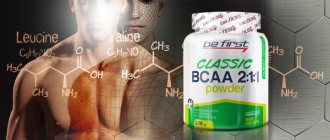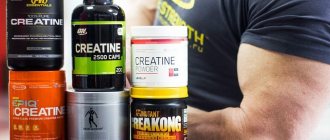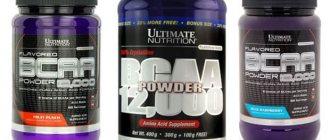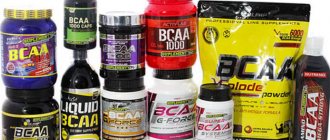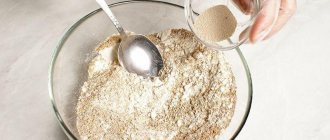To achieve maximum results by taking sports supplements, you need to know how to do it correctly. Amino acids are the building blocks for your muscles. We'll tell you how to take amino acids and which ones are the best.
You have been training hard for a long time, moving towards a specific goal. This can be a strength goal - “press a barbell of 150 kg”, an endurance goal - “run a marathon in 4 hours”, or a transformation goal - “lose 5 kg” or pump up muscles. To achieve the best results at a certain stage of the movement towards your goal, your body will need support.
Let's figure out what types and complexes of amino acids exist, as well as how, when and in what volume it is better to take amino acids.
Why do you drink amino acids?
So, amino acids. In any sport and in bodybuilding, great importance is attached to them, because all proteins in the body consist of amino acids , and protein is the building material of our muscles.
The body uses amino acids for growth, restoration, strengthening, production of hormones, enzymes, antibodies, and so on. That is, almost all processes occurring in our body depend on them.
If the fastest proteins begin to be absorbed 30 minutes after intake, then amino acids begin to be absorbed within 15 minutes.
Even the simplest exercises that you perform at moderate intensity waste almost 80% of the amino acids in the body. Therefore, it is so important to choose the right sports nutrition for muscle growth and take additional amino acids so that your muscles recover better and faster after training.
The body experiences particular stress during drying the body or losing weight and, of course, it needs additional nutrition for problem-free muscle hypertrophy during peak loads.
Now that it is clear why not a single athlete can do without taking amino acids, especially when he or she begins to train hard. But which ones are better and how to drink amino acid complexes correctly? We continue to search for answers together.
Comparison table of essential amino acids
Essential acids
| Name | Description |
Key BCAA amino acids:
| Suitable for athletes who want to quickly gain muscle mass and achieve new results in the gym. BCAAs play a key role in protein synthesis, reduce the pain threshold and are the main source of strength and energy, due to which the body's endurance during training will significantly increase. |
| Lysine | If you are often sick, have a weak immune system and skin problems, your body may be lacking lysine. It is involved in the body's absorption of calcium and collagen synthesis. Improves the quality of skin and hair, reduces the threshold of fatigue and improves concentration. Can be used for children with lysine deficiency in the body. |
| Methionine | For liver problems, doctors often prescribe methionine. It reduces the level of harmful cholesterol in the blood, removes toxins and heavy metals from the body. Accelerates protein metabolism in the body. |
| Threonine | Threonine is involved in the construction of muscle proteins, so it will help athletes who have problems gaining weight. It is also used for diseases of the liver and gastrointestinal tract. The amino acid is involved in the decomposition of urea, eliminates fatty deposits in the liver and takes an active part in metabolic processes. |
| Tryptophan | Depressed mood, chronic anxiety and constant apathy can be caused by a lack of important hormones in the body. Tryptophan is involved in the synthesis of melatonin and serotonin, thereby reducing stress and improving mood. Tryptophan improves the functioning of the nervous system and helps people experiencing problems with insomnia and depression. Returns vigor and brightness to life, strengthens the immune system and removes harmful cholesterol from the body. |
| Phenylalanine | Problems with the central nervous system and regular outbreaks of severe stress can be caused by a lack of phenylalanine. It is involved in the synthesis of norepinephrine, tyrosine and dopamine, which strengthen the nervous system and improve its functioning. Phenylalanine works as an antidepressant, restoring good mood, calmness and joy of life. It also has a positive effect on memory and helps with chronic anxiety. |
Nonessential amino acids
| Arginine | Arginine will be the best choice for athletes who want to quickly gain muscle mass. It promotes the production of growth hormone and muscle pumping, and has an antioxidant effect. Arginine also stimulates testosterone production and helps strengthen the nervous system. |
| Asparagine | People experiencing problems with apathy and chronic fatigue will benefit from aspartic acid. It lowers the threshold for fatigue, strengthens the immune system, converts glucose and replenishes glycogen stores. |
| Glutamine | Glutamine will be an excellent help in the fight against increased fatigue and fatigue. It increases performance and vitality. |
| Glutamic acid | If you have problems concentrating and cannot focus on one task for a long time, then glutamic acid will help you out. It normalizes blood sugar levels, improves concentration and improves brain performance. |
| Glycine | Many people, due to their work or lifestyle, experience anxiety and psycho-emotional stress. In this case, glycine comes to the rescue, which normalizes the functioning of the nervous system, reducing tension and improving concentration. It increases the body's cognitive abilities, strengthens the immune system and provides the body with oxygen for the formation of new cells. |
| Carnitine | Carnitine will help people who have problems with excess weight. If you combine it with daily physical activity, it will greatly speed up your weight loss process. Carnitine transforms fats into energy by transporting fatty acids to the mitochondria, where they are broken down. |
| Ornithine | Often stress and illness slow down the body's metabolism and growth. Ornithine prevents the body from slowing down, being a key element in the synthesis of growth hormone and metabolism. Ornithine is also used in the prevention of chronic liver diseases. By lowering the level of ammonium in the blood, it slows or stops the progression of the disease. |
| Proline | Due to a sedentary lifestyle, many people experience problems with the spine, cartilage, and joints. Proline is the body's main assistant in the fight against problems such as sprains, arteriosclerosis, muscle failure, as well as back, lower back and neck pain. This amino acid is an excellent tool for the prevention of cardiovascular diseases, cancer and arteriosclerosis. |
| Serin | If you suffer from fibromyalgia, your body is likely deficient in serine. The amino acid also prevents the development of cancer, strengthens the nervous system and immunity. Many people experience problems with chronic anxiety, stress and insomnia. Serine, promoting better brain function, relieves stress, helps achieve a calm state and improves sleep quality. |
| Taurine | Taurine will help people who have trouble focusing and concentrating. It has a beneficial effect on the nervous system, restoring and strengthening it. It also slows down the aging process in the body and accelerates metabolic processes. |
| Citrulline | Citrulline will come to the aid of athletes who cannot recover for a long time after training. It removes lactic acid and ammonia from the body and restores ATP reserves after heavy physical exertion. During training, the amino acid will improve the body's performance and strength and help the athlete achieve better results in the gym. |
Conditionally essential
| Tyrosine | Tyrosine will help people trying to cope with chronic fatigue, depression and anxiety disorders. It reduces fatigue, enhances adaptability to psychological and physical stress, stimulates brain function, and improves concentration skills. |
| Cysteine | Cysteine will help solve digestive problems. It neutralizes toxic substances in the body. Restores the digestive system and gastrointestinal tract. Its effect is enhanced by taking vitamin C. |
| Histidine | Histidine will help people with weak immune systems, protecting the body from infections, viruses and radiation. Promotes rapid removal of metals and toxins from the body. Strengthens the immune system. Provides rapid tissue recovery and growth. |
| Beta-alanine | Beta-alanine will be a wonderful aid for bodybuilders. It stimulates the growth of muscle mass and increases their performance, being a powerful source of energy. Takes part in the processing of sugars and strengthens the immune system. |
Which amino acids are better
Now let's move on to the most important question - which amino acids are best to take? In fact, it all depends on the individual characteristics of the athlete. We will present average data that is typical for the majority.
What amino acids exist
There are more than 20 different types of amino acids and 9 of them are called essential, that is, the body cannot produce them on its own and receives them only through food. It’s not for nothing that these 9 essential amino acids (or BCAAs) are separated into a separate group, because they make up almost 35% of muscle tissue.
The remaining amino acids are called non-essential; they are absorbed by the body very quickly and are required mainly during or immediately after training, as well as in the morning. In addition, they contain quite a few calories, inhibit catabolism well, reduce appetite and preserve muscles, so if you decide to lose weight, then you simply need to take amino acids.
Since almost all beginners start with the question “recommend good amino acids,” let’s start with isolated (individual) amino acids - all of them provide muscle growth:
- BCAA, as mentioned above, activates anabolic processes, protects and nourishes muscle tissue;
- Arginine also improves muscle nutrition by delivering nutrients to them;
- Glutamine also nourishes and restores muscles;
- L-carnitine is a “promoted” amino acid that allows you to burn fat, but, as practice has shown, it does not do this very effectively;
- Beta-alanine – promotes muscle tissue regeneration;
- Citrulline - returns energy lost during training and nourishes muscles, saturating them with useful substances.
Valine, isoleucine and leucine form a powerful amino acid BCAA, which is also a powerful anabolic steroid. It regenerates muscle tissue, eliminating microcracks, accelerates muscle growth and saturates it with energy. This amino acid is taken before and after workouts, and immediately after getting up in the morning.
Types of amino acids in sports nutrition
There are 22 proteinogenic amino acids in total. They are divided into several groups depending on whether the body produces them and in what volume. According to this criterion, the following are distinguished:
- Irreplaceable. They are not produced by the body and can only be obtained from food and sports supplements.
- Replaceable. They are synthesized in the body, although during intense training or heavy physical activity a deficiency may still occur.
- Conditionally replaceable. They are produced by the body, but in a much smaller volume, which is required for a person, including an athlete.
A separate group includes amino acids that are not part of the protein structure, but play an important role in metabolism:
- carnitine,
- taurine,
- ornithine,
- GABA.
How to take complex amino acids correctly?
To ensure maximum results from taking amino acids, follow simple rules.
The minimum dosage of amino acids is 5 g, but to achieve maximum results, you need to take 10-20 g at a time.
For better absorption of amino acids, take 50 mg of vitamin B6 daily, which is necessary for their breakdown. Also include more vitamin C in your supplement list. Pay attention to how you are feeling, if you are feeling nauseous and sluggish, you should change your supplements.
You should consult your doctor before taking amino acids, especially if you are taking other supplements or medications. Always adhere to the dosages indicated on the package.
When is the best time to take amino acids?
If you want to lose weight, then the time between taking amino acids should be reduced: drink amino acids in the morning, before and after fat-burning workouts.
But if your goal, on the contrary, is to pump up muscles of impressive size, then you can limit yourself to taking amino acids before and after your weight training.
Amino acids are also surprising in that their intake can be combined with all types of sports nutrition. However, keep in mind that different types of amino acids cannot always be taken at the same time.
Their intake should not be combined with protein, gainers or energy bars, which, one way or another, will reduce the rate of absorption of amino acids.
Learn more about which brand of BCAA is best to take and how to take BCAA.
How to combine amino acids with nutrition?
All muscles are made of protein, and if there is not enough protein in the food (and often this is the case), then there are not enough amino acids. Your job is to choose the best amino acids and make them an integral part of your daily diet.
Let's look at “natural” amino acids. The most protein, accordingly, is in the white of a chicken egg. Next, in terms of the ratio of this valuable element, comes fish, beef, poultry and all “milk”.
Important facts about muscles
Muscles are full-fledged components of the body; they provide high-quality motor function. Some of them are responsible for internal fastening and movement, and the second for external parts of the body. All muscle fibers take an active part in a person’s ability to move normally, and also ensure the proper functioning of internal systems (the heart, lungs and other organs are made of muscles).
There are several classifications of muscles, mainly based on the histological structure or method of work. There are 2 main categories:
- Smooth. Their work does not depend on human consciousness; the peripheral nervous system is used to control internal muscles.
- Cross-striped. These include all the muscles that influence the functioning of the skeleton, and in addition the heart, which has a unique structural principle and is distinguished by a huge productivity resource. To set the skeletal muscles in motion, the tension of consciousness and the transmission of impulse are sufficient.
To contract muscle fibers, a nerve impulse is required, which sets in motion 2 main proteins - actin and myosin. They begin to move in the tissues in relation to each other, this sets in motion the process of muscle contraction and stretching.
A healthy human body has 656 muscles, which occupy from 23 to 40% of the total weight. Every day they take on the bulk of the body's work. The load falls mainly on large muscle joints - the thigh biceps, buttocks, quadriceps, the work of the leg muscles allows you to move.
Muscle growth or bodybuilding is the purposeful increase in the size of certain muscle tissues through strength training
The muscular system consumes the largest amount of energy from the entire body; only the central nervous system (CNS) can compare with it. All muscles use a pair to function normally, which balances each other’s contraction.
Every agonist also has an antagonist:
- for biceps it is triceps;
- for the hamstring biceps it is the quadriceps;
- for the chest – these are the lats.
Thanks to this relationship, strong stretching of the muscles is prevented, which can lead to injuries and sprains.
Interestingly, some bodybuilders use the technique of severe antagonist fatigue to better train the agonist.
The body independently adapts to the stress of intense training by adapting metabolism, central nervous system function, and bone position. The automatic body adjustment system leads to greater muscle productivity, and they become able to withstand greater loads. The initiation of such reactions begins only at the start of classes. Metabolism is also prone to adaptation; it tries to cover the increased needs of the body. Amino acids are used to maintain beneficial reactions in a stable manner.
The best amino acid complexes
Traditionally, products from the manufacturer Ultimate Nutrition take first place in terms of price-quality ratio and contain whey protein hydrolysate, which is so necessary for increasing muscle mass.
Superior Amino 2222 from Optimum Nutrition is in second place. It has performed well in practice, and its price is reasonable for its quality. Supplements are available in two forms - capsules and tablets. The capsules also contain whey protein hydrolysate, and the tablets also contain whey protein concentrate.
Super Amino 4800 from Dymatize is a “normal” amino acid, not the worst, but also inferior in quality and effectiveness to all of the above.
The following products are popular in the CIS.
TOP pharmaceutical drugs
First of all, we offer a top rating of pharmaceutical drugs. It looks like this.
4th place – L-glutamine capsules
Glutamine is a conditionally essential amino acid. Necessary for improving the functioning of the immune system, as well as gaining muscle mass. Glutamine is quite expensive when compared with other pharmaceutical amino acids, on average about 1000 rubles per package.
© nipadahong — stock.adobe.com
Take capsules 2 times a day. They have the following effect:
- fill with energy;
- help the body recover faster;
- strengthen the immune system;
- help muscle growth.
3rd place – Alvezin
This is a combined drug containing a complex of essential amino acids, namely alanine, arginine, aspartic acid, glutamic acid; histidine, isoleucine, leucine, lysine, methionine, phenylalanine, tryptophan, valine. In addition, the medicine contains potassium, sodium and magnesium.
The drug is administered intravenously or drip 400 ml once every 3 days, only under the supervision of a doctor. It is important to establish that the medication is well tolerated. Use the product only during intense physical activity; under no circumstances should it be abused. Side effects may occur. The course lasts from 14 to 21 days.
2nd place – Methionine
It is an essential amino acid that is part of proteins. Methionine improves liver function, reduces the amount of bad cholesterol in the body, and also has an antidepressant effect.
Take 500 mg 3 times a day. As a rule, it is prescribed to those who suffer from protein deficiency, liver pathologies, and dystrophy. It is forbidden to take Methionine if you are hypersensitive to the amino acid, as well as with viral hepatitis.
Sold in any pharmacy, 50 tablets. Approximate cost: 100 rubles.
1st place – Glycine
It was included in the rating because it is an amino acid that is present in many proteins. Our body urgently needs glycine during prolonged stressful situations, in a state of increased excitability, as well as during intense physical activity.
© mikrostoker — depositphotos.com. Useful properties of glycine
The drug is taken in a course of 3 times a day (100 mg) for a month. If urgently necessary, the course can be repeated. In case of hypersensitivity to an amino acid, it is better not to take it.
You can buy glycine at any pharmacy, the cost of one pack is about 50 rubles (30 tablets).
Mandatory Supplements
These supplements are not intended to improve your workout performance, muscle, endurance, or strength. They just might help you stay healthy and provide your daily vitamin and mineral needs.
Multivitamins and minerals
People who do strength training and/or diet (a balanced but calorie-restricted diet - what I always call a diet) need more vitamins and minerals than people with a sedentary lifestyle.
Any vitamin-mineral complex in digestible form can be very useful. Good brands are presented, for example, on iHerb.com, in the pro brands section.
Fish fat
If there's one nutrient that modern diets (outside of the handful of people who eat a lot of fatty fish) can't get enough of, it's fish oil.
Fish oil is the hottest supplement today, and companies are investing a lot of money in research, so the research base has accumulated large. Omega-3 fatty acids normalize metabolism, protect the heart, help fats oxidize more vigorously, and help control inflammation. It's easier to list what fish oil doesn't do.
If you cannot or do not want to eat fatty fish (salmon, mackerel, herring, etc.) up to 5 times a week, then try taking fish oil supplements, choosing companies that ensure high-quality purification of heavy metals from it.
Flaxseed oil is commonly suggested as an omega-3 alternative to fish oil. However, the body's conversion of flaxseed omega-3 into EPA/DHA is very inefficient in most people. In addition, flaxseed oil oxidizes very quickly and becomes almost harmful. The average recommendation for athletes for EPA / DHA is 1.8-3.0 g per day.
Calcium
Calcium deficiency is a very common thing, especially in people who refuse dairy products (and it is fashionable to refuse dairy products these days).
Calcium is fundamentally important for women. Women are much more likely than men to suffer from osteoporosis during menopause. Therefore, you should start taking care of your bone health as early as possible. And calcium is not just about teeth, bones and nails - it plays an important role in muscle contraction, that is, during any movement. Without calcium, muscle movement is basically impossible, so the body has a large storage area for it - bones. When there is a calcium deficiency in food, “bone” calcium is used.
The minimum daily dose of calcium is 1000 mg in a highly digestible form (citrate, malate).
If you want to get all your calcium from dairy products, then note that 100 grams of cottage cheese contains 120-150 mg of calcium. That is, even 3 standard packs of cottage cheese per day do not replenish the calcium requirement. Hard cheeses contain the most calcium (600-1200 mg), but due to their fat content, cheeses cannot be considered as the main source of calcium.
Zinc and magnesium
People who do strength training are often deficient in magnesium and zinc:
zinc - for those who refuse red meat;
magnesium - for those who do strength training, because its losses increase with heavy training.
Both minerals are very important for the body. Additionally, some studies show that combining zinc and magnesium at night helps with sleep and recovery. On average, the daily intake of zinc is 25 mg (the preferred form is picolinate), magnesium is 400-500 mg (citrate is the best form for absorption, while the oxide is most often seen on sale).

